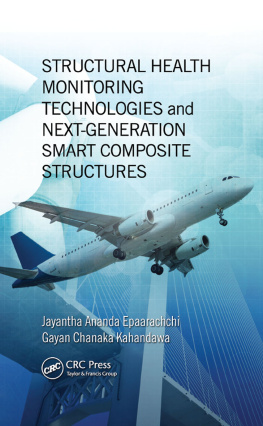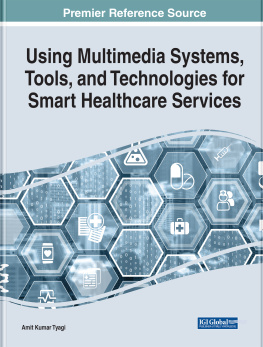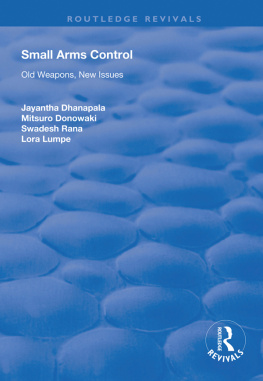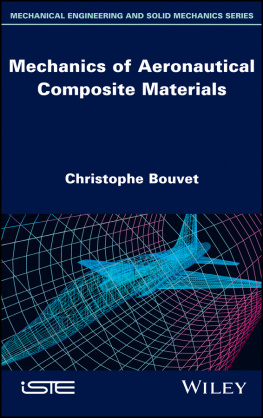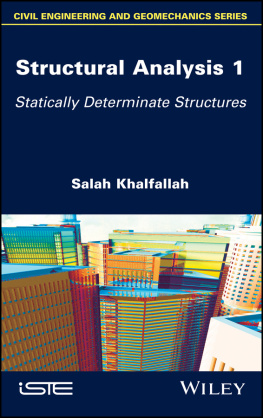Epaarachchi Jayantha Ananda - Structural health monitoring technologies and next-generation smart composite structures
Here you can read online Epaarachchi Jayantha Ananda - Structural health monitoring technologies and next-generation smart composite structures full text of the book (entire story) in english for free. Download pdf and epub, get meaning, cover and reviews about this ebook. year: 2016, publisher: CRC Press, genre: Home and family. Description of the work, (preface) as well as reviews are available. Best literature library LitArk.com created for fans of good reading and offers a wide selection of genres:
Romance novel
Science fiction
Adventure
Detective
Science
History
Home and family
Prose
Art
Politics
Computer
Non-fiction
Religion
Business
Children
Humor
Choose a favorite category and find really read worthwhile books. Enjoy immersion in the world of imagination, feel the emotions of the characters or learn something new for yourself, make an fascinating discovery.
- Book:Structural health monitoring technologies and next-generation smart composite structures
- Author:
- Publisher:CRC Press
- Genre:
- Year:2016
- Rating:4 / 5
- Favourites:Add to favourites
- Your mark:
- 80
- 1
- 2
- 3
- 4
- 5
Structural health monitoring technologies and next-generation smart composite structures: summary, description and annotation
We offer to read an annotation, description, summary or preface (depends on what the author of the book "Structural health monitoring technologies and next-generation smart composite structures" wrote himself). If you haven't found the necessary information about the book — write in the comments, we will try to find it.
Structural health monitoring technologies and next-generation smart composite structures — read online for free the complete book (whole text) full work
Below is the text of the book, divided by pages. System saving the place of the last page read, allows you to conveniently read the book "Structural health monitoring technologies and next-generation smart composite structures" online for free, without having to search again every time where you left off. Put a bookmark, and you can go to the page where you finished reading at any time.
Font size:
Interval:
Bookmark:

STRUCTURAL HEALTH MONITORING TECHNOLOGIES and NEXT-GENERATION SMART COMPOSITE STRUCTURES
Composite Materials: Analysis and Design
Series Editor
Ever J. Barbero
PUBLISHED
Structural Health Monitoring Technologies and Next-Generation Smart Composite Structures, Jayantha Ananda Epaarachchi and Gayan Chanaka Kahandawa
Braided Structures and Composites: Production, Properties, Mechanics, and Technical Applications, Sohel Rana and Raul Fangueiro
Strengthening Design of Reinforced Concrete with FRP, Hayder A. Rasheed
Smart Composites: Mechanics and Design, Rani Elhajjar, Valeria La Saponara, and Anastasia Muliana
Finite Element Analysis of Composite Materials Using ANSYS, Second Edition, Ever J. Barbero
Finite Element Analysis of Composite Materials using Abaqus, Ever J. Barbero
FRP Deck and Steel Girder Bridge Systems: Analysis and Design, Julio F. Davalos, An Chen, Bin Zou, and Pizhong Qiao
Introduction to Composite Materials Design, Second Edition, Ever J. Barbero
Finite Element Analysis of Composite Materials, Ever J. Barbero
STRUCTURAL HEALTH MONITORING TECHNOLOGIES and NEXT-GENERATION SMART COMPOSITE STRUCTURES
Jayantha Ananda Epaarachchi
Gayan Chanaka Kahandawa

MATLAB is a trademark of The MathWorks, Inc. and is used with permission. The MathWorks does not warrant the accuracy of the text or exercises in this book. This books use or discussion of MATLAB software or related products does not constitute endorsement or sponsorship by The MathWorks of a particular pedagogical approach or particular use of the MATLAB software.
CRC Press
Taylor & Francis Group
6000 Broken Sound Parkway NW, Suite 300
Boca Raton, FL 33487-2742
2016 by Taylor & Francis Group, LLC
CRC Press is an imprint of Taylor & Francis Group, an Informa business
No claim to original U.S. Government works
Printed on acid-free paper
Version Date: 20160331
International Standard Book Number-13: 978-1-4822-2692-8 (eBook - PDF)
This book contains information obtained from authentic and highly regarded sources. Reasonable efforts have been made to publish reliable data and information, but the author and publisher cannot assume responsibility for the validity of all materials or the consequences of their use. The authors and publishers have attempted to trace the copyright holders of all material reproduced in this publication and apologize to copyright holders if permission to publish in this form has not been obtained. If any copyright material has not been acknowledged please write and let us know so we may rectify in any future reprint.
Except as permitted under U.S. Copyright Law, no part of this book may be reprinted, reproduced, transmitted, or utilized in any form by any electronic, mechanical, or other means, now known or hereafter invented, including photocopying, microfilming, and recording, or in any information storage or retrieval system, without written permission from the publishers.
For permission to photocopy or use material electronically from this work, please access www.copyright.com (http://www.copyright.com/) or contact the Copyright Clearance Center, Inc. (CCC), 222 Rosewood Drive, Danvers, MA 01923, 978-750-8400. CCC is a not-for-profit organization that provides licenses and registration for a variety of users. For organizations that have been granted a photocopy license by the CCC, a separate system of payment has been arranged.
Trademark Notice: Product or corporate names may be trademarks or registered trademarks, and are used only for identification and explanation without intent to infringe.
Visit the Taylor & Francis Web site at
http://www.taylorandfrancis.com
and the CRC Press Web site at
http://www.crcpress.com
Contents
Simon Laflamme and Filippo Ubertini
Nozomi Saito, Takashi Yari, Kazuo Hotate, Masato Kishi, Yoshihiro Kumagai, Satoshi Matsuura, and Kiyoshi Enomoto
Gayan Chanaka Kahandawa, Jayantha Ananda Epaarachchi, John Canning, Gang-Ding Peng, and Alan Lau
Aravinda S. Rao, Jayavardhana Gubbi, Tuan Ngo, Priyan Mendis, and Marimuthu Palaniswami
Jinhao Qiu, Chao Zhang, Jinling Zhao, and Hongli Ji
Zhanjun Wu, Rahim Gorgin, Dongyue Gao, and Yinan Shan
Viviana N. Meruane
Ratneshwar (Ratan) Jha and Sudhirkumar V. Barai
Ayad Arab Ghaidan Kakei, Jayantha Ananda Epaarachchi, M. Mainul Islam, and Jinsong Leng
Ranjan Ganguli
Ratneshwar (Ratan) Jha, Rani Warsi Sullivan, and Ramadas Chennamsetti
Hongli Ji, Jinhao Qiu, Hongyuan Wang, and Chao Zhang
W.S. Al Azzawi, Jayantha Ananda Epaarachchi, M. Mainul Islam, and Jinsong Leng
B. Gangadhara Prusty and Ali Naem S. Alamry
Half a century after their commercial introduction, composite materials are of widespread use in many industries. Applications such as aerospace, windmill blades, and highway bridge retrofit require designs that ensure safe and reliable operation for 20 years or more. Using composite materials, virtually any property, such as stiffness, strength, thermal conductivity, and fire resistance, can be tailored to the users needs by selecting the constituent material, their proportion and geometrical arrangement, and so on. In other words, the engineer is able to design the material concurrently with the structure. Also, modes of failure are much more complex in composites than in classical materials. Such demands for performance, safety, and reliability require that engineers consider a variety of phenomena during the design. Therefore, the aim of this Composite Materials: Analysis and Design book series is to bring to the design engineer a collection of works written by experts on every aspect of composite materials that is relevant to their design.
Variety and sophistication of material systems and processing techniques have grown exponentially in response to an ever-increasing number and type of applications. Given the variety of composite materials available as well as their continuous change and improvement, the understanding of composite materials is by no means complete. Therefore, this book series serves the practicing engineer as well as the researcher and student who are looking to advance the state-of-the-art knowledge in understanding material and structural response and developing new engineering tools for modeling and predicting such responses.
Thus, the series is focused on bringing to the public existing and developing knowledge about materialproperty relationships, processingproperty relationships, and the structural responses of composite materials and structures. The series scope includes analytical, experimental, and numerical methods that have a clear impact on the design of composite structures.
Over the past few decades there have been many breakthroughs in the development of smart materials and miniaturization of sensors. The innovations and advancement of micro- and nanoscale sensor technologies have brought the development of smart structures closer to reality, attracting enormous research attention. The focus of this technology is to bring to fruition diagnosis/self-prognosis and self-healing capabilities in composite structures.
Increased usages of fiber-reinforced composites in advanced engineering fields have created an overwhelming demand for smart/intelligent composite materials that can be utilized in designing next generation products. Moreover, the rising concern about possible failures in composite materials is leading to another unavoidable expectation for intelligent and live diagnostics systems in so-called smart composite structures. This is especially important for aerospace vehicles that need all of their constituent parts to be at optimal performance. Globally, the development of structural health monitoring (SHM) systems and smart structures are being pushed forward by the physical phenomena/properties inherited by new materials as well as new adaptive sensing and control measures. The stress/strain response, acoustic emission, wave propagation, vibration, and damping of materials are some of the physical phenomena/properties that are widely used in the SHM field. The use of electrically activated polymers and shape memory alloys are good examples of advanced smart materials. Although there has been a significant involvement, smart structures are not limited to the use of smart materials and integrated SHM systems. The smart structures are being developed with innovative design concepts using the smart materials inherent physical and mechanical properties.
Font size:
Interval:
Bookmark:
Similar books «Structural health monitoring technologies and next-generation smart composite structures»
Look at similar books to Structural health monitoring technologies and next-generation smart composite structures. We have selected literature similar in name and meaning in the hope of providing readers with more options to find new, interesting, not yet read works.
Discussion, reviews of the book Structural health monitoring technologies and next-generation smart composite structures and just readers' own opinions. Leave your comments, write what you think about the work, its meaning or the main characters. Specify what exactly you liked and what you didn't like, and why you think so.

